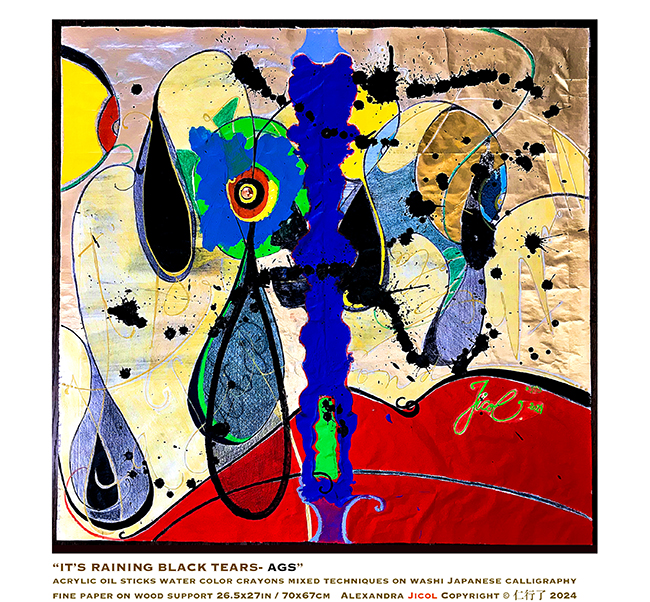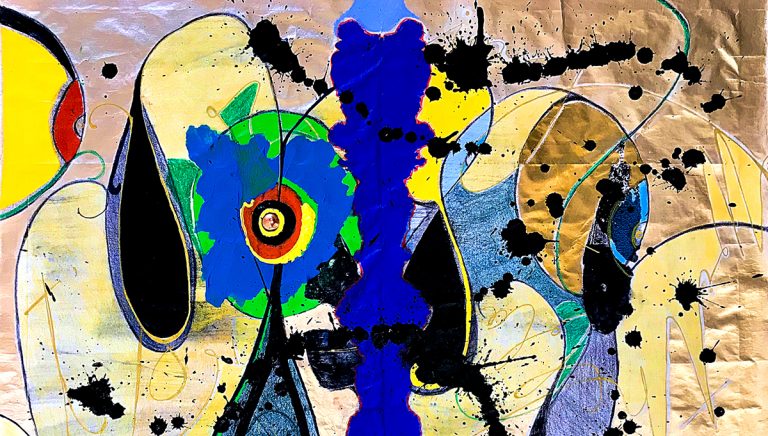Alexandra Jicol, a Romanian artist, was born and raised in Bucharest during a time of political oppression and deprivation of basic rights. Her childhood was a blend of two starkly contrasting worlds: the serene mountains, where she spent half her time, and the bustling city of Bucharest, where she roamed the halls of the Romanian television studios where her mother worked. This duality of experiences instilled in her a deep curiosity and a keen sense of observation, which continue to inspire her work to this day.

In her own words, Jicol describes herself as a simple observer and a traveler through life. Her goal is to look, hear, explore, learn, express, share, and appreciate all things, striving to do so with a nonjudgmental and tolerant soul. This philosophy permeates her art, which is a reflection of her innermost thoughts and observations.
One of Alexandra Jicol’s works is “IT’S RAINING BLACK TEARS- AGS,” a piece that dives deep into the emotional and symbolic terrain she often explores. Created using a blend of acrylics, oil sticks, watercolor crayons, and mixed techniques on washi Japanese calligraphy fine paper, this artwork is a testament to Jicol’s skill in merging traditional methods with modern expression. The use of washi paper, known for its delicate yet resilient nature, adds an extra layer of meaning to the piece, as it reflects both the fragility and strength of the human spirit.
Measuring 26.5×27 inches (70×67 cm), the painting is a visual exploration of the emotional complexities of grief, love, and the persistence of hope. The black tears in the work are not merely drops of sorrow but symbols of deeper, unfulfilled desires and lost love. These tears are a representation of the darkness that often overshadows the brighter, hopeful aspects of our inner selves. Yet, even as the tears fall, there is an underlying brightness—a suggestion that beneath the surface of grief, the rays of hope continue to shine, keeping us alive and resilient.
The symbolism of tears is a recurring motif in Jicol’s work, reflecting a range of emotions from joy to pain to awe. In this particular piece, the tears are connected to another common element in her art: the eye. The eye, with its many religious, philosophical, and spiritual connotations, serves as a window into the soul, a way of seeing and being seen. Through the eyes, the world is both observed and interpreted, and in Jicol’s art, they become a powerful symbol of the human experience.
Another significant element in “IT’S RAINING BLACK TEARS- AGS” is the red lips, which represent the experience of the senses—specifically, the taste and tasting of life. The lips are a reminder of the pleasures and pains of living, the bittersweet nature of existence. In this context, they also symbolize the quest for love, a theme that runs throughout Jicol’s work.
This quest for love is poignantly captured in a poem by Jicol titled “Sometime when it rains.” The poem, much like the painting, delves into the emotional landscape of love, loss, and the search for meaning. In the verses, Jicol speaks of the healing power of rain, the way it washes away self-pity and helps one face their destiny. The poem reflects the same themes of vulnerability, beauty, and resilience that are evident in “IT’S RAINING BLACK TEARS- AGS.”
Through her art and poetry, Jicol explores the idea that even in the face of the most traumatizing life events, there remains an unbreakable core of beauty, purity, and authenticity within us. Her work is a reminder that these qualities cannot be easily erased, no matter how much darkness life throws our way.
In “IT’S RAINING BLACK TEARS- AGS,” Jicol invites viewers to contemplate their own experiences of grief and hope, to see the beauty that persists even in the midst of sorrow. The painting, with its rich symbolism and emotional depth, is a powerful expression of the artist’s philosophy and a testament to her ability to translate complex feelings into visual form.
As with all of Jicol’s artworks, this piece is an original, a one-of-a-kind creation that reflects her unique perspective on life. She insists that no copies, giclées, or prints are allowed, except in small formats for catalogs or promotional events. This commitment to originality underscores the personal and intimate nature of her art, making each piece a true reflection of her journey as an observer and traveler through life.

